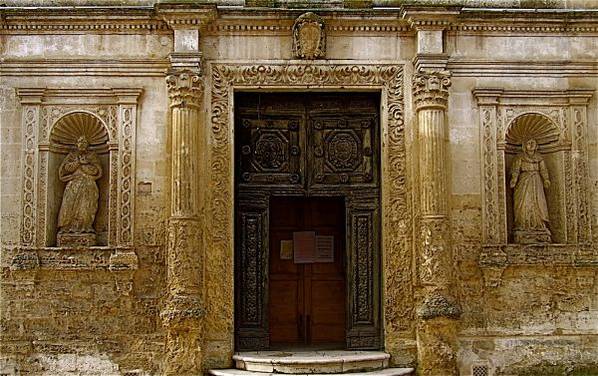
Outside
Santa Chiara was built by the will of the archbishop of Matera Antonio del Ryos Culminarez between 1668 and 1702 in the “new houses” district, built for the employees of the seminary, which according to the dictates of the Council of Trent was to be present in each diocese has a finely worked facade framed by pilasters, surmounted by Corinthian capitals, while the portal is flanked by two fluted columns of a classical mold. What is striking is the rational organization of the spaces that echo Renaissance motifs and the similarity of the facade to the layout of a sixteenth-century polyptych, that is, a picture made up of several panels.
In the niche in the center statue of the Madonna del Carmine, while in the niches on the sides of the portal, on the right San Francesco and on the left Santa Chiara. In the central niche above, a figure of God the blessing father. The wooden door, end of the XVIII century, is decorated with leaf elements and with the coat of arms of the Archbishop of Ryos and is inserted in a rich portal decorated with various floral motifs according to the Baroque of the time which repeats the same archiepiscopal coat of arms made in limestone.
Inside
The interior of the church of Santa Chiara has a single nave ending in a pointed arch, unusual for the time, echoing, as an architectural element, to the Gothic period in which this element was basic in church buildings. The church is embellished with numerous altars. Of particular effect is the large wooden elevation placed on the main altar. Inside the riser there are two panels that represent, on the left, Saint Agnese, a Roman girl who suffered martyrdom probably under the emperor Decius and who for her very young age and perhaps also for the meaning of her name is considered the patroness of innocence, and alongside Santa Rosa, a Dominican Peruvian tertiary, canonized for its exemplary virtues in 1671.
Above the large wooden elevation, the choir is visible, a place where the cloistered nuns exercised their offices of worship. In the center is the large eighteenth-century canvas with the Madonna and Child, Saint Clare and Saint Francis of Assisi, always liturgically combined, being both the forefathers of the female and male branch of the Franciscan order. The altars on the left side are dedicated respectively, the first to San Michele Arcangelo, the second to the Immaculate Virgin. On the walls of the nave several paintings dated between the second half of the eighteenth and the first years of the nineteenth century depicting, starting from the Madonna del Rosario, San Gioacchino with Sant’Anna and a young Madonna and finally the Presentation of the Child Jesus to the old Simeone. The wooden pulpit on the right, carved, gilded and polychrome in a pentagonal shape is a valuable work of Lucan craftsmanship of the early eighteenth century, saints of the Order of the Poor Clares are carved in the panels. After the pulpit, altars dedicated respectively to Christ and Saint Anna.